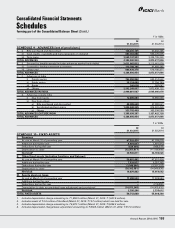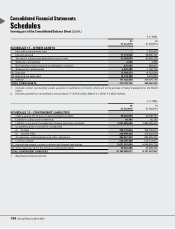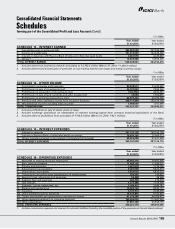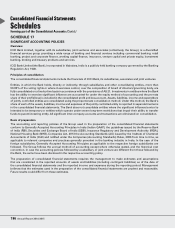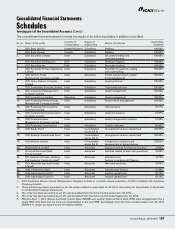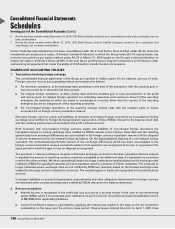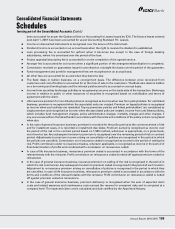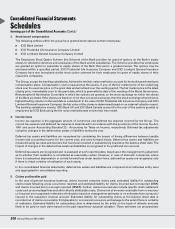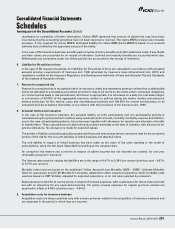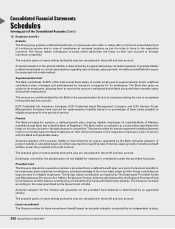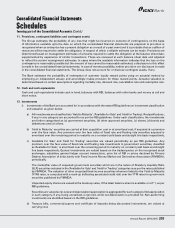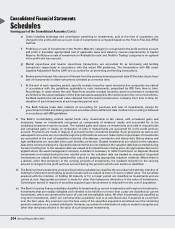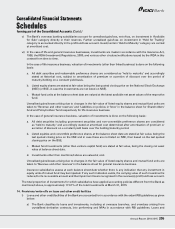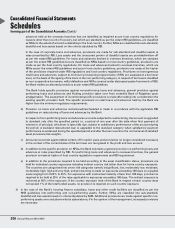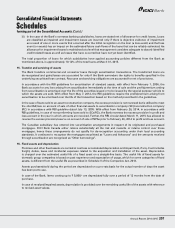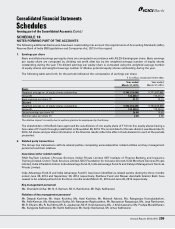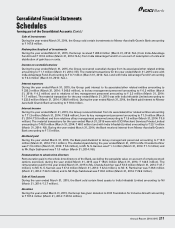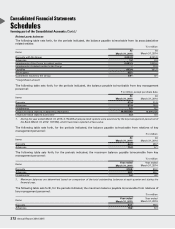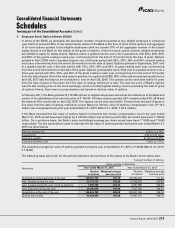ICICI Bank 2015 Annual Report Download - page 205
Download and view the complete annual report
Please find page 205 of the 2015 ICICI Bank annual report below. You can navigate through the pages in the report by either clicking on the pages listed below, or by using the keyword search tool below to find specific information within the annual report.
forming part of the Consolidated Accounts (Contd.)
Schedules
203Annual Report 2014-2015
Consolidated Financial Statements
11. Provisions, contingent liabilities and contingent assets
The Group estimates the probability of any loss that might be incurred on outcome of contingencies on the basis
of information available upto the date on which the consolidated financial statements are prepared. A provision is
recognised when an enterprise has a present obligation as a result of a past event and it is probable that an outflow of
resources will be required to settle the obligation, in respect of which a reliable estimate can be made. Provisions are
determined based on management estimates of amounts required to settle the obligation at the balance sheet date,
supplemented by experience of similar transactions. These are reviewed at each balance sheet date and adjusted
to reflect the current management estimates. In cases where the available information indicates that the loss on the
contingency is reasonably possible but the amount of loss cannot be reasonably estimated, a disclosure to this effect
is made in the consolidated financial statements. In case of remote possibility, neither provision nor disclosure is made
in the consolidated financial statements. The Group does not account for or disclose contingent assets, if any.
The Bank estimates the probability of redemption of customer loyalty reward points using an actuarial method by
employing an independent actuary and accordingly makes provision for these reward points. Actuarial valuation is
determined based on certain assumptions regarding mortality rate, discount rate, cancellation rate and redemption rate.
12. Cash and cash equivalents
Cash and cash equivalents include cash in hand, balances with RBI, balances with other banks and money at call and
short notice.
13. Investments
i) Investments of the Bank are accounted for in accordance with the extant RBI guidelines on investment classification
and valuation as given below.
a) All investments are classified into ‘Held to Maturity’, ‘Available for Sale’ and ‘Held for Trading’. Reclassifications,
if any, in any category are accounted for as per the RBI guidelines. Under each classification, the investments
are further categorised as (a) government securities, (b) other approved securities, (c) shares, (d) bonds and
debentures and (e) others.
b) ‘Held to Maturity’ securities are carried at their acquisition cost or at amortised cost, if acquired at a premium
over the face value. Any premium over the face value of fixed rate and floating rate securities acquired is
amortised over the remaining period to maturity on a constant yield basis and straight line basis respectively.
c) ‘Available for Sale’ and ‘Held for Trading’ securities are valued periodically as per RBI guidelines. Any
premium over the face value of fixed rate and floating rate investments in government securities, classified
as ‘Available for Sale’, is amortised over the remaining period to maturity on constant yield basis and straight
line basis respectively. Quoted investments are valued based on the trades/quotes on the recognised stock
exchanges, subsidiary general ledger account transactions, price list of RBI or prices declared by Primary
Dealers Association of India jointly with Fixed Income Money Market and Derivatives Association (FIMMDA),
periodically.
The market/fair value of unquoted government securities which are in the nature of Statutory Liquidity Ratio
(SLR) securities included in the ‘Available for Sale’ and ‘Held for Trading’ categories is as per the rates published
by FIMMDA. The valuation of other unquoted fixed income securities wherever linked to the Yield-to-Maturity
(YTM) rates, is computed with a mark-up (reflecting associated credit risk) over the YTM rates for government
securities published by FIMMDA.
Unquoted equity shares are valued at the break-up value, if the latest balance sheet is available or at ` 1, as per
RBI guidelines.
Securities are valued scrip-wise and depreciation/appreciation is aggregated for each category. Net appreciation
in each category, if any, being unrealised, is ignored, while net depreciation is provided for. Non-performing
investments are identified based on the RBI guidelines.
d) Treasury bills, commercial papers and certificate of deposits being discounted instruments, are valued at
carrying cost.


